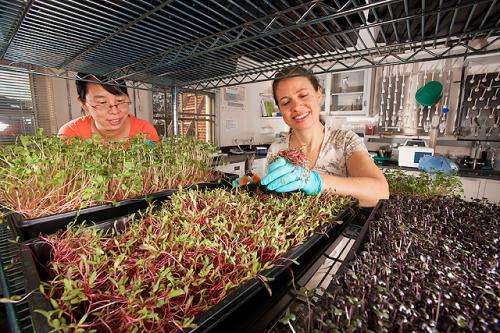Specialty greens pack a nutritional punch

"Microgreens" is a marketing term used to describe edible greens which germinate from the seeds of vegetables and herbs and are harvested without roots at the seedling stage. The plants at the seedling stage have two fully expanded cotyledons, or seed leaves. They are considered a specialty genre of colorful greens that are good for garnishing salads, soups, plates and sandwiches.
A U.S. Department of Agriculture (USDA) researcher has led a team of scientists who analyzed the key nutrients in 25 different varieties of vegetable microgreens. The study results could be used to estimate levels of vitamins and nutrients in microgreens, according to the scientists.
The study was led by Agricultural Research Service (ARS) plant physiologist and national program leader Gene Lester at Beltsville, Md. ARS is USDA's chief intramural scientific research agency.
The team determined the concentration of essential vitamins and carotenoids in the microgreens. Key nutrients measured were ascorbic acid (vitamin C), tocopherols (vitamin E), phylloquinone (vitamin K), and beta-carotene (a vitamin A precursor), plus other related carotenoids in the cotyledons that are critical for human health and function.
The team showed that different microgreens contained widely differing amounts of vitamins and carotenoids. Total vitamin C content ranged from 20 to 147 milligrams (mg) per 100 grams of cotyledon fresh weight, depending on which plant species was being tested. The amounts of the carotenoids beta-carotene, lutein/zeaxanthin, and violaxanthin ranged from about 0.6 mg to 12.1 mg per 100 grams of fresh weight. For comparison, an average apple weighs 100-150 grams. In general, microgreens contained considerably higher levels of vitamins and carotenoids—about five times greater—than their mature plant counterparts.
Among the 25 microgreens tested, red cabbage, cilantro, garnet amaranth, and green daikon radish had the highest concentrations of vitamin C, carotenoids, vitamin K and vitamin E, respectively. Growing, harvesting, and handling conditions may have a considerable effect on nutrient content. Additional studies are being conducted to evaluate the effect of agricultural practices on nutrient retention.
More information: Read more about this research in the January 2014 issue of Agricultural Research magazine.
Provided by Agricultural Research Service


















